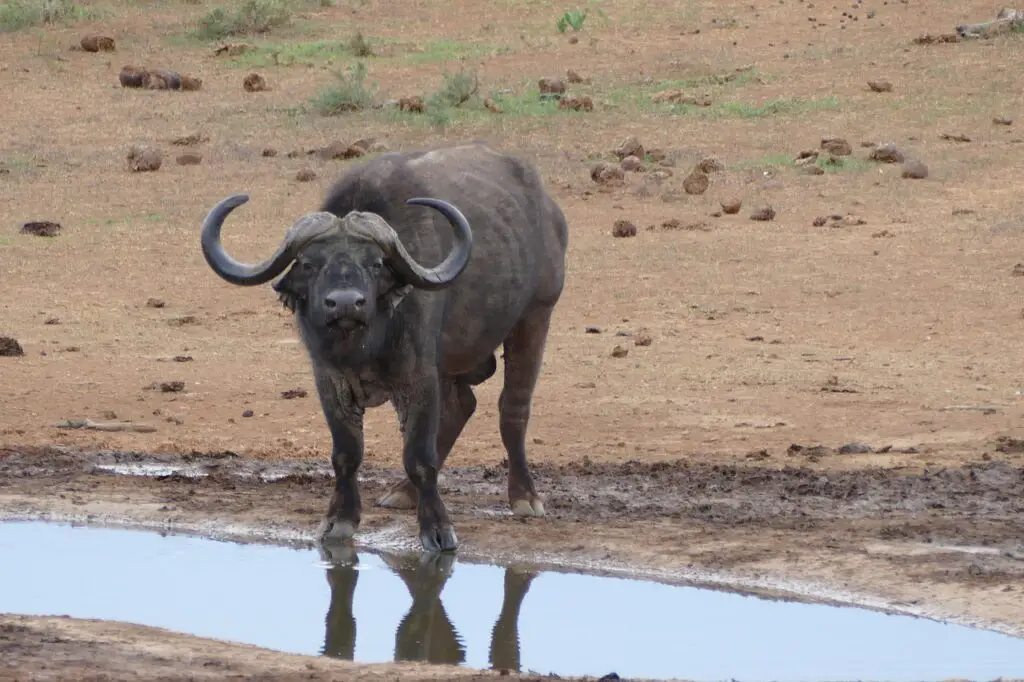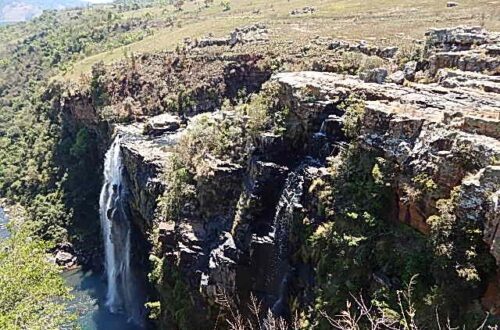Addo Elephant National Park: Where Elephants Roam Free in South Africa’s Wilderness.

Addo Elephant National Park.
Location and History of Addo Elephant National Park.
Nestled in the Eastern Cape province of South Africa, Addo Elephant National Park is a treasure trove of biodiversity. Originally established in 1931 to protect the dwindling population of African elephants in the region, the park has since expanded and now spans over 180,000 hectares. It is situated near the Sundays River Valley, offering visitors a unique blend of scenic beauty and wildlife encounters.
Size and Importance of Addo National Park.
As South Africa’s third-largest national park, Addo is home to a staggering array of plant and animal species. Its significance lies not only in its size but also in its role as a sanctuary for endangered and indigenous wildlife. The park’s dedication to conservation ensures the preservation of these species for generations to come.

Accessibility and Visitor Information.
Getting to Addo National Park is easy, with nearby airports in Gqeberha (formerly Port Elizabeth) and East London providing convenient access. Once inside the park, visitors can explore its wonders through self-drive safaris or by joining guided tours led by knowledgeable park rangers. Accommodation options within the park range from cozy chalets to picturesque campsites, offering visitors a chance to immerse themselves in the tranquil beauty of their surroundings.
Flora and Fauna of Addo National Park.

Diverse Plant Life in Addo National Park.
Addo National Park boasts a remarkable variety of plant life, with a unique combination of coastal, valley bushveld, grassland, and mountainous ecosystems within its boundaries. From the towering spekboom trees, considered to be a natural carbon sink, to the delicate wildflowers that blanket the landscape during spring. The park’s flora enchants visitors at every turn.
Indigenous and Endangered Species.
At Addo National Park, conservation takes center stage, providing a safe haven for endangered and indigenous wildlife. The park is particularly renowned for its successful efforts in protecting the African elephant population, which has more than quadrupled since its inception. Other iconic species, such as the endangered black rhino and the elusive Cape buffalo, also find refuge within the park’s borders.
Birdlife and Avian Diversity.
Bird enthusiasts will delight in the avian diversity of Addo National Park. With over 400 recorded species, the park offers ample opportunities for birdwatching. From majestic raptors soaring through the skies to vibrant sunbirds flitting among the flowers. The birdlife of Addo is a sight to behold and a birdwatcher’s paradise. The SASOL Red Bishop Bird Hide is located opposite the waterhole in the main rest camp and overlooks a small wetland area. The Spekboom Tented Rest camp and Hide contains pristine Albany thicket vegetation. Visitors can experience the bush first-hand and spot some of the smaller creatures and birds that frequent this habitat.

The Big Five and Other Wildlife at Addo National Park.
The Iconic Big Five Animals.
No visit to Addo National Park would be complete without seeking out the “Big Five”; Elephants, lions, leopards, rhinoceros, and buffalo. Addo is one of the few places in South Africa where visitors can witness not only five of these majestic creatures in their natural habitat. But the “Big Seven”, includes the Southern right whale and Great white shark in its marine environment. The park’s responsible conservation efforts make encounters with these iconic animals both thrilling and awe-inspiring.
Other Notable Wildlife Species.
Beyond the Big Five, Addo National Park is home to an abundance of other fascinating wildlife. The park is inhabited by spotted hyenas, warthogs, zebras, and various antelope species. Including the charmingly shy and elusive mountain zebra. The diverse range of wildlife ensures that every safari in Addo is filled with exciting discoveries.

Tracking and Spotting Wildlife.
Spotting wildlife in Addo National Park is an adventure in itself. Whether you embark on a guided game drive or explore on your own, keep your eyes peeled for signs of animal activity. Watch for fresh tracks in the sand, listen for alarm calls from birds or other animals, and keep your camera ready for unexpected encounters. Patience and observation are key to experiencing the magic of Addo’s wildlife.
Exploring the Different Ecosystems in Addo National Park.
Coastal and Marine Ecosystems.
While renowned for its terrestrial biodiversity, Addo National Park also offers a glimpse into its coastal and marine ecosystems. The park’s marine protected area extends along the coastline, providing a sanctuary for various marine species. Visitors can witness the splendor of marine life through guided boat tours, where dolphins, whales, and a myriad of seabirds often make an appearance.

Valley Bushveld and Grassland Habitats.
The valley bushveld and grassland habitats of Addo National Park create a tapestry of colors and textures. These ecosystems support numerous species, from grazing antelope to predators. Meandering through these landscapes, visitors can witness the interconnectedness of flora and fauna, gaining a deeper appreciation for the delicate balance that sustains life in the park.
Mountainous Areas and Forests.
As you venture into Addo’s mountainous areas and forests, a sense of tranquility envelops you. The cool shade of towering trees offers respite from the African sun, and the melodious tunes of birds fill the air. Exploring these ecosystems opens a window into a different world, where baboons swing through trees and secretive leopards leave their mark. Addo National Park’s diverse ecosystems have something to captivate every nature enthusiast.
Conservation Efforts and Success Stories at Addo National Park.

Preservation of Endangered Species.
Addo National Park is not just a beautiful getaway for nature lovers; it is also a sanctuary for endangered species. It is famous among tourists for its large elephant herds that graze on the vegetation and parade calmly. You can witness these marvelous creatures by simply traveling to one of the waterholes, which is a hot spot for elephants.
The park has played a crucial role in the preservation and protection of several endangered species, including the black rhino, and the Cape buffalo. Through dedicated conservation efforts, Addo has helped to increase the populations of these incredible creatures, ensuring their survival for future generations.
Habitat Restoration and Management.
The biodiversity found within Addo National Park is made possible through careful habitat restoration and management. The park’s rangers and conservation teams work tirelessly to maintain a healthy and balanced ecosystem by managing vegetation, controlling invasive species, and ensuring the availability of water sources. Their efforts help to create a thriving environment for the park’s diverse wildlife, from the smallest insects to the largest mammals.
Collaborative Conservation Initiatives.

Addo National Park understands that conservation is not a one-person job. Through collaborative initiatives, the park actively partners with local communities, research institutions, and other conservation organizations to share knowledge, resources, and expertise. These partnerships have led to innovative conservation projects, such as community-based conservation programs and research studies on wildlife behavior. By working together, Addo aims to create a lasting impact on biodiversity conservation beyond the boundaries of the park.
Unique Experiences and Activities for Visitors at Addo National Park.
Game Drives and Safari Tours.
No visit to Addo National Park is complete without embarking on a thrilling game drive or safari tour. Hop into an open safari vehicle and let an experienced guide take you on a journey through the park’s stunning landscapes. Get up close and personal with elephants, lions, zebras, and other iconic African wildlife. The excitement of spotting these majestic creatures in their natural habitat is an experience you won’t forget.
Hiking and Walking Trails.
For those who prefer a more active adventure, Addo National Park offers a variety of hiking and walking trails like the Alexandria Hiking Trail. Explore the park’s diverse terrain on foot and discover hidden gems along the way. From short, scenic walks to longer, more challenging hikes, there’s a trail to suit every level of fitness and interest. Immerse yourself in nature, breathe in the fresh air, and keep an eye out for unique plant species and smaller creatures that call Addo home.

Camping and Accommodation Options.
To truly immerse yourself in the beauty of Addo National Park, consider staying overnight. The park offers a range of camping and accommodation options to suit different preferences and budgets. Spend a night under the stars at one of the park’s well-equipped campsites or indulge in the luxury of a safari lodge. Wake up to the sounds of chirping birds and the sight of wildlife roaming nearby. It’s an unforgettable experience that will make your visit to Addo even more memorable.
4×4 Trail.
If you’re up for an adventure, you’ve got to check out the Bedrogfontein 4×4 Trail. It’s like stepping into a time machine because this trail is packed with history! Back in the day, there were some intense battles between the British and Afrikaner troops during the Anglo-Boer war right here. You can even find cool rock art paintings scattered around the area.
But hold on, this trail isn’t for just any old car. You’ll need a 4×4 vehicle with low-range facilities to tackle the terrain and make sure we don’t harm the environment. The route is about 45km long and has a difficulty level of 2 – 3, which means it’s not too wild but still exciting. You can easily finish it in around 6 hours.
Now, here’s the deal. You can only drive this route one way, starting from Kabouga and ending at Darlington. Kabouga is about 40km away from the main park entrance, near Kirkwood. Darlington, on the other hand, is around 150km away from the main entrance. So make sure you plan accordingly! If you want to stay overnight, you’ve got a couple of options. You can camp at the Mvubu campsite or stay at the Kabouga Cottage, both on the Kabouga side of the trail. Just remember to bring your own firewood if you want to have a cozy campfire.
Oh, and fishing enthusiasts, listen up! You can do some fishing at the Mvubu campsite and Darlington Dam. So don’t forget to pack your fishing gear if that’s your thing.So, grab your 4×4, get ready for an awesome journey through different types of vegetation, and immerse yourself in history. Have a blast!

Marine Eco-tours.
As Addo Elephant National Park is home to the ‘Big 7’, guests might want to partake in a Marine Eco-tour in order to catch a glimpse of a great white shark and/or southern right whale.
Tips for Planning a Visit to Addo National Park.
Why Go?
Well, first of all, you don’t have to worry about getting sick from malaria there, which is pretty awesome. Plus, it’s home to the Big 7, which means you can see not only elephants but also other cool animals like lions, rhinos, and even whales and great white sharks! The park is like a huge sanctuary for all sorts of unique and diverse wildlife. And guess what? They’ve got everything well organized with great facilities and stuff, so you won’t have to rough it out in the wild. You can choose from different places to stay, and they even have different prices to fit your budget. So, if you’re into animals and want to have an amazing adventure, Addo Elephant National Park is the place to be!
Best Time to Visit Addo National Park.
The best time to visit Addo National Park depends on your preferences. The dry winter months from May to September(avoid crowds) offer cooler temperatures and a higher chance of spotting wildlife near water sources as there is little water in the bush. However, the lush green landscapes of summer (November to February) make for a picturesque backdrop. Consider the weather, animal sightings, and your personal preferences when deciding on the ideal time for your visit.
Entry Fees and Permits.
To enter Addo National Park, visitors are required to pay an entry fee. The fees vary depending on the type of vehicle and the number of occupants. It is recommended to check the official park website for up-to-date information on entry fees and permits. Remember to book your permit in advance to ensure a smooth entry into the park and to avoid disappointment.

Safety Guidelines and Park Regulations.
While exploring Addo National Park, it is important to follow safety guidelines and park regulations. Always keep a safe distance from wildlife and never feed or approach animals. Stay on designated trails and roads to protect the fragile ecosystem. Be mindful of fire safety and ensure you dispose of waste responsibly. By respecting the park’s regulations, you can help preserve its natural beauty and ensure a safe and enjoyable experience for all visitors.
In conclusion, Addo National Park stands as a testament to the importance of conservation and the incredible biodiversity that South Africa holds. From the iconic Big Five to the unique plant life and thriving ecosystems, this park offers an unforgettable experience for visitors.
As we bid farewell to Addo National Park, let us remember the significance of protecting and preserving these natural habitats, ensuring that future generations can continue to explore and be inspired by the wonders of South Africa’s rich biodiversity. So, plan your visit, immerse yourself in the beauty of Addo National Park, and leave with a deep appreciation for the incredible natural world that surrounds us.

FAQ
Is Addo National Park home to all of the Big Five?
Addo National Park is home to four out of the Big Five animals, namely elephants, lions, buffalos, and rhinos. While it does not have any resident leopards, the park is still a fantastic destination to witness a diverse range of wildlife.
Are there accommodation options available within Addo National Park?
Yes, Addo National Park offers a variety of accommodation options to suit different preferences, including campsites, chalets, and luxury lodges. Visitors can choose to stay within the park or explore nearby accommodation options in the surrounding areas.
Are self-drive safaris allowed in Addo National Park?
Yes, visitors are permitted to embark on self-drive safaris through designated routes within the park. These routes are well-maintained and signposted, allowing visitors to explore the park at their own pace while adhering to the park’s rules and regulations.
What is the best time to visit Addo National Park?
The best time to visit Addo National Park depends on your interests and preferences. The winter months (May to September) offer cooler temperatures and a higher chance of spotting wildlife around water sources. Meanwhile, the summer months (October to April) bring lush vegetation and migratory bird species. Ultimately, any time of the year can provide a unique and rewarding experience in the park.





2 Comments
Sudhir Bhattathiripad
Great post… well laid out, brilliant photographs and loads of relevant information.
Best of Luck… Keep it up….
Efisio Saverio Mannai
Thank you Sudhir,I try to grow 🪴